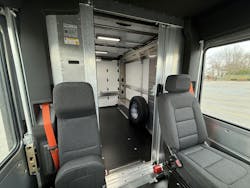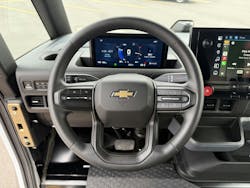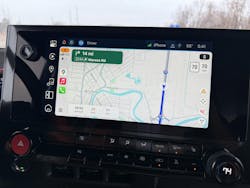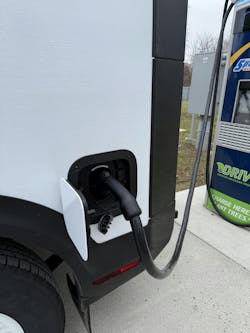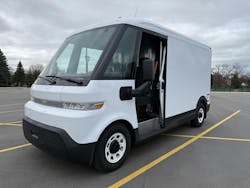Chevrolet BrightDrop 400 review: An EV built for delivery
The new 2025 Chevrolet BrightDrop is a battery-electric cargo van that’s purpose-built for the last-mile delivery segment. General Motors first debuted BrightDrop at the Consumer Electronics Show in 2021. While the brand has shared news of deliveries here and there throughout the years, we might finally begin seeing them on the road, as the vehicles are now available for purchase publicly.
I received the Chevrolet BrightDrop 400 and drove it around for a full week. Here are my impressions:
How BrightDrop compares on power
The van’s capacity is in its name. The BrightDrop 400 features a 153-inch wheelbase, offering 400 cu. ft. of cargo space, and a maximum payload of 3,710 lb. The difference between the BrightDrop 400 and the nearly identical BrightDrop 600 is that the 600 is a bit longer, with a wheelbase of 183 inches, offering 600 cu. ft. of cargo space and a 3,350-lb. max payload.
Chevrolet touts this electric cargo van’s range at 272 combined city and highway miles on all-wheel drive models equipped with the manufacturer’s “Max Range” battery, which I reviewed. The BrightDrop features an estimated range of 193 city miles and 151 highway miles with the standard battery.
But estimated range and actual range are two different things. FleetOwner breaks this down further here.
What are BrightDrop’s safety and tech features?
The BrightDrop is designed for work, and its technology and creature comfort offerings reflect that. This means that while you’ll still get the driver assistance safety technology and a few BrightDrop-specific tech perks, the vehicle still feels very much like a commercial rig.
In my opinion, the most significant tech to talk about with this van is the BrightDrop-exclusive tech.
Delivery Mode with the power doors package
When in BrightDrop’s “delivery mode,” which can be easily switched on and off with the click of a button, the vehicle automatically performs certain functions to help speed up the delivery process for the driver. Once in park, the BrightDrop’s cabin lights turn on, and the bulkhead door unlocks automatically. When the vehicle is shifted out of park, the cabin lights turn off, the bulkhead door locks, and the van horn sounds twice to alert anyone near that the vehicle is about to move.
Adding the Power Door Package to the BrightDrop enhances its Delivery Mode. In addition to the automatic cabin lights, instead of simply unlocking, the power doors on the curbside and bulkhead automatically open when shifted to park. When shifting to drive, the doors automatically close.
The BrightDrop I drove was equipped with power doors, and when used in Delivery Mode, it was a great feature. However, when I tried to use the doors without the delivery mode, it seemed the curbside door would get confused. Sometimes, it would open easily upon pressing the “open” button outside, and other times, it would only unlock, causing me to manually slide the door open. Typically, this wouldn’t be a problem, but when manually sliding the door open, I felt I was actively pushing against the door’s motor. Using the door’s open lever from the inside felt the same way. For this reason, I elected to exclusively use the door’s open and close buttons on the key fob or the steering wheel.
You read that right. The steering wheel features open and close buttons for both the curbside door and the bulkhead door. The curbside door’s buttons are on the back of the steering wheel on the right side, and the bulkhead door’s functions are on the left side. Once I observed that the power doors seem to prefer being operated using power instead of manual, I typically stuck to the buttons on the steering wheel and the key fob.
One thing about the doors that I learned the hard way was that when you intend to turn off the vehicle, it’s necessary to exit from the driver’s side. For the first few days of driving, I exited from the curbside door because I parked on the street. One time, I exited the van, went inside to grab my dog, and took him on a 10-minute walk. When I returned, I noticed that the radio in the van was still playing and the infotainment screen was still illuminated after all that time. I went out about 15 minutes later and realized that the vehicle had completely powered down, but not without wasting precious battery life.
I brought this to the attention of my contact at General Motors, who advised that I begin exiting from the driver’s side when I turn off the vehicle. This solved the problem immediately. Reader, learn from my mistake.
See also: The 2025 Ram HD lineup makes trailering easy—even without experience
How BrightDrop prioritizes safety with its tech
The BrightDrop is equipped with driver assistance and safety features, and all of those features—more than 20—are standard.
These include automatic emergency braking, automatic pedestrian and cyclist braking, forward collision alert, front and rear park assist, lane keep alert and assist, automatic high beam headlights, and more. The forward collision alert and the lane keeping alert also include driver’s seat vibrations.
The BrightDrop features multiple cameras to assist the driver, including blind spot cameras that activate with the use of turn signals and a 360-degree view camera. All camera views are displayed on the 11.3-inch infotainment screen. While the blind spot camera views are helpful, it is worth noting that their quality could be improved.
Another safety feature is the automatic task lighting that illuminates on the back of the vehicle if it detects motion with the key fob nearby.
Infotainment system breakdown
The BrightDrop features an infotainment system with built-in Google support, giving the operator access to Google Maps and other Google apps. Upon entering the vehicle, I signed into my Google account on the infotainment screen and found all my favorite and most-visited addresses in the Google Maps app.
The BrightDrop also features wireless Apple CarPlay and Android Auto—a requirement for my own personal tastes. While I never had connectivity issues with Apple CarPlay or my phone in the BrightDrop, my one gripe with the system was that when using the Google Maps app within Apple CarPlay, the map only showed a compass view of my navigation. To get a directional view of my navigation, I had to move from Apple CarPlay’s Google Maps to BrightDrop’s built-in Google Maps app.
How did the Chevrolet BrightDrop drive?
The BrightDrop is an electric vehicle, and it drives like one. FleetOwner compares the differences of driving an electric vehicle versus an ICE vehicle here. As for non-EV-specific driving features, I outline those below:
Typically, I always enjoy driving cargo vans because of their ride height, which automatically increases visibility. But many OEMs are optimizing visibility even more so—GM included.
The Bright Drop features large windows, large mirrors, a 360-degree camera, and blind spot/side view cameras that automatically deploy when the turn signal is activated. The BrightDrop also has an extremely large windshield, which is what I believe is the most attention-grabbing feature of the van’s exterior.
I found that visibility wasn’t much of an issue for me while driving the BrightDrop, but it’s worth noting that there is no rearview mirror in this van—not even one that’s essentially a rear-view camera monitor. When I asked about it, the response was: “Where would we put it?”—which is fair. The windshield feels a good 5 feet from the driver's seat, and any rear-view mirror or camera monitor would need to be unusually large to benefit any driver.
There were times when I absolutely enjoyed driving the Brightdrop. I appreciated its low step height, visibility, and one-pedal driving. But there were also times when it was a bit frustrating. I already mentioned the confusion with the power doors and my frustration with the Google Maps within the Apple CarPlay app, but I also experienced something else.
It rained on the day we drove north, and there was an obvious leak in the cabin area. It wasn’t significant, and it didn’t appear to be near anything that would cause a problem. While it seemed to have resolved itself by the next day when it rained even harder, a leak is something you never want to see in a new vehicle.
Overall impressions of the Chevrolet BrightDrop
The fact that it produces zero tailpipe emissions and will require less maintenance automatically make it tempting. Still, the price point might cause it to take some significant use time before you see any economic advantage (the exact model I drove comes with nearly a $92,000 price tag).
Further, while I have yet to drive the Ford E-Transit and have only driven the Ram Promaster EV a short distance, I noticed a significant difference between traditional cargo vans and the BrightDrop, which comes down to the interior appointments.
The interiors of both the Ram ProMaster EV and the Ford E-Transit are similar to both brands’ passenger vehicle offerings and even more like the ICE versions of these vans. However, the Brightdrop is very clearly designed as a commercial vehicle, leaving out those similar dashboards, traditional cup holder spaces, and even glove compartment storage areas. Instead, storage and cup holders are moved elsewhere, wiring under the dash is clearly exposed, and simply operating doors—at least in the “power door package”—requires the operator to re-learn a few behaviors that might once have been second nature.
These aren't cons of the BrightDrop, but perhaps simply features that will take time for drivers to get used to. Once they do, the BrightDrop can potentially increase last-mile delivery driver efficiency—while producing zero tailpipe emissions.
About the Author
Jade Brasher
Senior Editor Jade Brasher has covered vocational trucking and fleets since 2018. A graduate of The University of Alabama with a degree in journalism, Jade enjoys telling stories about the people behind the wheel and the intricate processes of the ever-evolving trucking industry.
